Middle-Earth Roleplaying by Plague of Hats
The HP Count of a Balrog
Original SA post
You know what? Fuck this shit. It's time for a behind the scenes look at
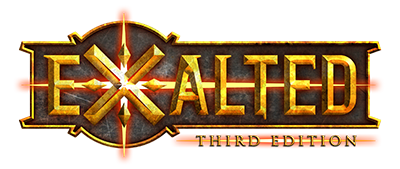
Haha no, just kidding. Imma FF MERP!
MIDDLE-EARTH ROLEPLAYING
Second Edition Core book
Lord of the Rings
is the second set of "real" books I ever read. (The first are the excellent and far more concise
Prydain Chronicles
that got me reading things other than sequential art boxes containing Spider-men and Flashes.) Once upon a time I owned three different editions of
Lord of the Rings
in varying iterations of one to three volumes. I still have my original copy of
The Silmarillion
, its cover barely hanging on thanks to some neon green Elmer's applied in the depths of high school. In synchronicity with
Lord of the Rings
being the first books that I bought and owned,
Middle-earth Role Playing
was the first RPG book I ever
bought
pestered my mother to buy for me.
For the better part of a decade after that I was the worst kind of Tolkien nerd. I count myself lucky that the internet was more difficult and less permanent back then. It's easy now to admit that the detailing of a modern novel combined with the storytelling sensibilities of an ancient epic don't always make for the most gripping experience. Still I want to tell you about these old, dusty books. There's a lot left in them to love, even twenty or more years after the fact. Of course, with a game this old there's plenty to snicker at and roll your eyes over, too—especially if you're a Tolkien nerd.
So, let me tell you how many hit points a balrog has!
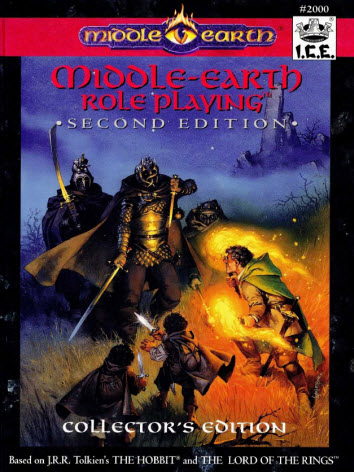
Is that Viggo Mortensen on the right? Yeah, that looks like him. Hi, Viggo!
This cover is by Angus McBride, like so many others from Iron Crown Enterprises (ICE; MERP's publisher) and the MERP line in particular. He's dead now, and so is this game line, but while they were together he was an icon of glorious Middle-earth art. When the line was starting, his enthusiasm for
Lord of the Rings
made him jump at the chance to provide cheap rates and free already-finished art to the fledgling ICE. There are many McBride pieces scattered throughout the books, especially the core, and a whole lot of the cover art for the game line is by him. While Angus McBride is King of Art on the covers, he has to share the inside of the books with the Queen, Liz Danforth. She is a super cool lady who is
still alive
and
still doing game art
.
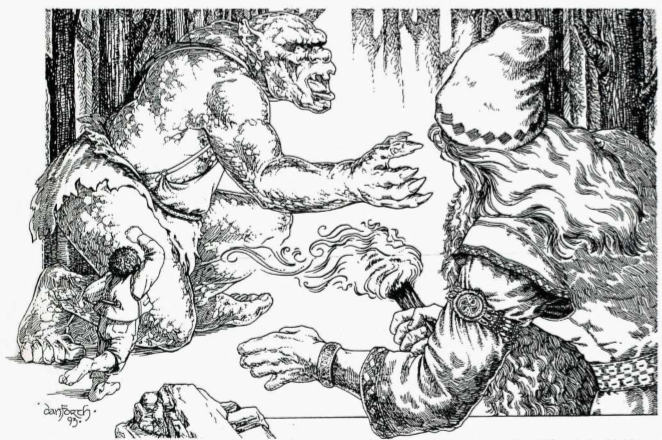
Remember how Bilbo just went crazy berserker after that troll's nuts? Yeah, me neither!
Enough happy memories! Here's the first page of the table of contents:
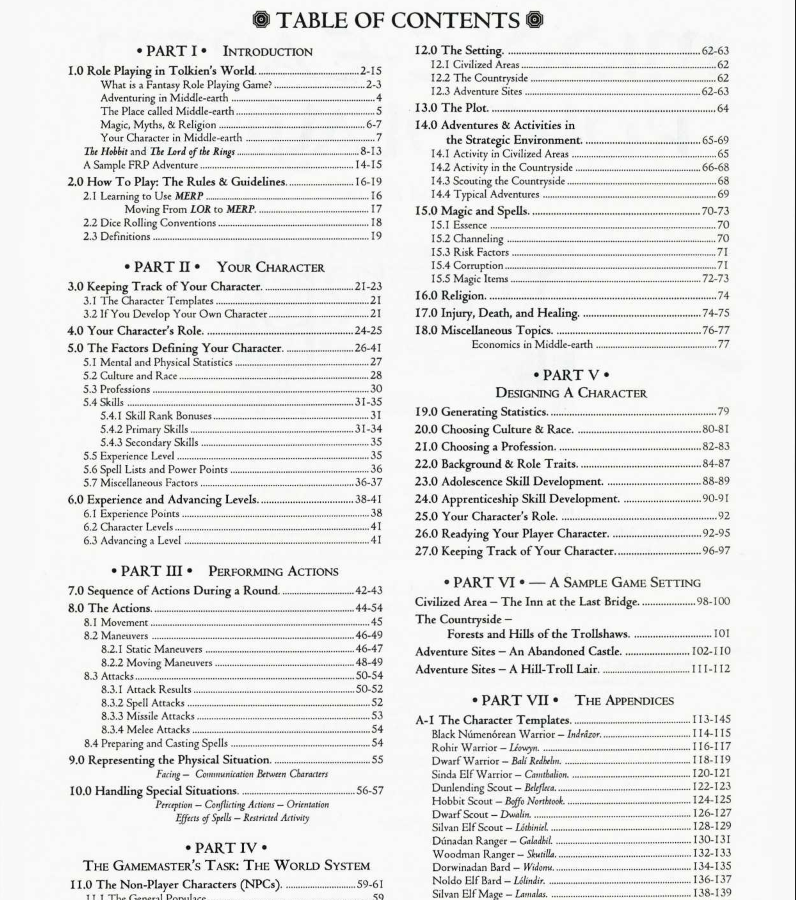
Yeah, this is reflective of ICE. I mean, it's not really a bad TOC, but man, just glance at that. It's like an accounting sheet. And "The Setting" is three pages long? Fuck! Oh, well.
The book proper begins with Part I • Introduction. We're greeted with:
quote:
"Three rings for the Elven-kings under the sky,
Seven for the Dwarf-lords in their halls of stone,
Nine for Mortal Men doomed to die,
One for the Dark Lord on his dark throne
In the Land of Mordor where the Shadows lie.
One Ring to rule them all, One Ring to find them,
One Ring to bring them all, and in the darkness bind them
In the Land of Mordor where the Shadows lie."
—Gandalf quoting an ancient verse to Frodo Baggins
LotR I , p. 81.
This haunting quote captures the essence of the saga known as The Lord of the Rings . The stirring words refer to the epic struggle of Eru's Children—Elves, Dwarves, and Men—against the frightening evil spawned by the Dark Lord, Sauron of Mordor. This tale ranks among the greatest annals of fantasy. Its setting, Middle-earth, is as rich a land as any in literature.
Hold up nerd. "Eru's Children"? Galadriel didn't say anything about that in the voiceover! Is this going to be on the test?
No, it's not. This introduction will make some use of the expanded "canon" of Tolkien's notes beyond LotR , but in all honesty it almost never matters throughout most of the game line. Sure, you can get a "deeper appreciation" for the write-up of Fëanor in Elves if you've read The Silmarillion . I'd feel the same way about a write-up of Sigurd after reading the The Ring of the Nibelung , but nine doctors agree that's not going to have much impact on my Knight of the Round in a Pendragon game. This shit's mostly here for nerds to nerd about, and to give bad GM's something to occasionally Elminster their players with.

There are a couple more paragraphs about how Middle-earth is great and this is a game about that. Then we proceed to a pretty typical "What is a Fantasy Role Playing Game?" section. Next up a more specific "Adventuring in Middle-earth" section that briefly tells the reader why they're here—because Middle-earth is in its way a gripping, deep setting, and that it has an elemental struggle of the righteous against the wicked that everyone can get into.
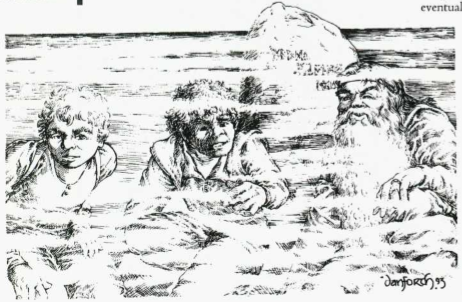
"You know what, Gimli? Yes. Yes there is such a thing as 'too much pipeweed.'"
"The Place Called Middle-earth" follows, where we get a little taste of what distinguishes MERP most from other Tolkien-based licensed RPGs. We don't just hear about the Shire and Gondor and Mordor. We are told about the continents of the world, Endor (Middle-earth), Aman (the Blessed Land) and Mórenorë (the Dark Land), amounting to a list of progressively less-detailed bits of setting notes from Tolkien's archives. A hallmark of ICE's approach to LotR was to take up the sparse loose threads from Tolkien's notes and weave grand, new, and frequently tonally-inconsistent frontiers. Here we just get a tiny taste, a little blurb about the Dark Land, and then a list of the seas of the world. There's Belegaer, the Great Sea you can find on the usual Middle-earth map everyone's at least glanced at, then there's Ekkaia and Haragaer, more names for things beyond the scope of LotR and, it will turn out, beyond the scope of the game line, too.
Now we come to one of the more pertinent parts that leans on the expanded canon, "Magic, Myths & Religion." This is more relevant than all that other world-building crap so far because the books barely stray beyond the borders of the Middle-earth we're all familiar with, but no fantasy setting would be complete without gods to swear about/on/to. This section very briefly describes the deity figures of Middle-earth, pulling information primarily from the first part of The Silmarillion that covers the creation myth of the setting. Here, I'll let it tell you:
quote:
Eru, the One—the only true deity—created Arda. First, however, he conceived the Ainur, or "Powers." The first beings to enter Tolkien's world, the Ainur actually shaped Arda according to Eru's scheme.
The Ainur are all-powerful, immortal spirits. They include the exalted Valar, like Manwë and Varda, as well as the Maiar, who include Sauron and the five Wizards. Most of the Ainur (including all but one of the Valar) remain faithful to their creator. Others, like Sauron and the Balrogs, have fallen from grace.
While their direct influence in Endor wanes with each passing Age, the Powers remain the most potent beings in Existence. The peoples of Middle-earth still worship their various incarnations in countless ways. After all, they represent Eru's Thought, his great Themes.
What follows is a list of the Valar, those spirits in the setting that most resemble your typical fantasy pantheon. They're listed with their "proper" name, an additional title/name, and then a sentence describing their
• Manwë:
 Pretty much King God. He's the Master of Air, which is relevant sometimes when the giant eagles come up, but mostly he's the basic stand-in for any invocation of "God" when Eru the For Reals God is too over-the-top an authority to swear on.
Pretty much King God. He's the Master of Air, which is relevant sometimes when the giant eagles come up, but mostly he's the basic stand-in for any invocation of "God" when Eru the For Reals God is too over-the-top an authority to swear on.
• Varda (Elbereth): Queen God, Mistress of the Stars. She's probably the most-invoked deity in all the Tolkien canon, because the Elves and her are Besties


 . She was the Power Word that Frodo yelled at the giant spider in the cave just before he got to Mordor.
. She was the Power Word that Frodo yelled at the giant spider in the cave just before he got to Mordor.
• Melkor (Morgoth):
 The Great Enemy. Pride Goeth Before the Fall, etc. Sauron was his right-hand sorcerer. Once the strongest of the Valar, Melkor screwed with Eru's original plan for the World and continued to do so after apologizing repeatedly because he is an Artist and you should respect his Vision. After some ancient shit went down the Elves named him Morgoth, "Black Enemy", and no one speaks his true name anymore. Morgoth's efforts diminished him to the point that the Valar
The Great Enemy. Pride Goeth Before the Fall, etc. Sauron was his right-hand sorcerer. Once the strongest of the Valar, Melkor screwed with Eru's original plan for the World and continued to do so after apologizing repeatedly because he is an Artist and you should respect his Vision. After some ancient shit went down the Elves named him Morgoth, "Black Enemy", and no one speaks his true name anymore. Morgoth's efforts diminished him to the point that the Valar

Of course, if I ever review Valar & Maiar you'll get two facefuls of lore nobody needs to care about.
The last bit of this part of the introduction is "Your Character in Middle-earth" which is pretty much just more "
 Middle-earth this is an RPG make it your own
Middle-earth this is an RPG make it your own
quote:
• A Magic System with simple yet comprehensive rules that reflect the unique nature of the use of magic and power in Middle-earth.
This is a lie. This is such a bald-faced, wrong-headed lie that it is terrifying in how wrong it is. Impressionable Tolkien fanatics lost hazy hours trying to reconcile this deception with the clear contradictions that were the printed magic rules in the book's pages. This is truly the Worst Thing.

But we'll get to that later. We're not even out of the Introduction yet! Don't worry, there's not much left. Well, there's a pretty big chunk left, but most of it is made up of synopses of The Hobbit and Lord of the Rings . You can git on over to Wikipedia or read the books if you don't know this shit already.
Mercifully we get to some real, bone-deep role playing stuff: A sample adventure. It's helpfully titled "A Sample FRP Adventure." It's presented as a transcript of the table talk between unnamed players as their characters seek shelter in an abandoned tower as night approaches. (As you do.) It stars Agonar the Elven Mage, Leanan the Dunlending Animist (hill folk shaman), Nári Zigildûn the Dwarven Warrior (noted to be of indeterminate gender because all Dwarves have beards), and Drogo Bracegirdle the

The group cautiously approaches the tower—by which I mean the Hobbit Scout sneaks up and everyone else piles up behind him. Luckily there's a treasure chest on the first floor because of course

 so everyone else prepares to loot the shit out of it while our Hobbit friend continues to search for danger. Nári covers the others with his crossbow and Leanan starts jimmying the chest. The Elven Mage casts
wingardium leviosa
because why the fuck not?
so everyone else prepares to loot the shit out of it while our Hobbit friend continues to search for danger. Nári covers the others with his crossbow and Leanan starts jimmying the chest. The Elven Mage casts
wingardium leviosa
because why the fuck not?
But hark and forsooth! There are three Orcs in the basement.
 They have stirred and are coming up the stairs! Nári immediately shoots one to death with a crossbow and then draws his battle-axe because
of course
They have stirred and are coming up the stairs! Nári immediately shoots one to death with a crossbow and then draws his battle-axe because
of course
 . Of the remaining Orcs one runs away and the other charges the defenseless and distracted Leanan. This being a Tolkien-esque fantasy where you play your favorite righteous heroes from the books, our timid, Hobbit
. Of the remaining Orcs one runs away and the other charges the defenseless and distracted Leanan. This being a Tolkien-esque fantasy where you play your favorite righteous heroes from the books, our timid, Hobbit
 Luckily, our levitating Mage uses his really useful vantage point to cast Sleep on the Orc charging the shaman, which makes it even easier for the Dwarf to crush the
Luckily, our levitating Mage uses his really useful vantage point to cast Sleep on the Orc charging the shaman, which makes it even easier for the Dwarf to crush the
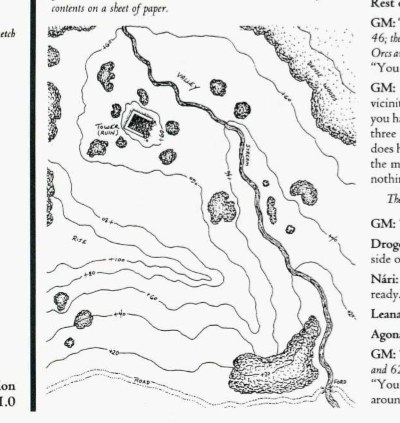
Even the example of play map sketch made your other RPG's maps feel inadequate.
This example of play demonstrates a bunch of concepts that will actually be introduced on the following pages, or even much later in the book.
 A peculiar mechanic is referred to as 'activity', where the GM measures some progress of the Orcs as they prepare to gather their gear and strike out. It's been a while, but I'm pretty sure this was only ever an optional rule in a very optional Rolemaster supplement from the mid-80's.
A peculiar mechanic is referred to as 'activity', where the GM measures some progress of the Orcs as they prepare to gather their gear and strike out. It's been a while, but I'm pretty sure this was only ever an optional rule in a very optional Rolemaster supplement from the mid-80's.

One of the key things it introduces to a newcomer are Rolemaster's conception of critical hits. This is just as much Greek as a similar D&D exercise if you've never played that game, but to a veteran role player of the 80's and 90's it teases what could be called a more robust and dynamic combat system. Hit points are counted in the dozens, "'D' Puncture criticals" skewer Orcs through the neck while "'C' Crush criticals" break legs. It's all very exciting to a bloodthirsty teenager, and one of the clearest signs of how MERP was 'Rolemaster lite' long before HARP and Rolemaster Express and all that stuff in between.
Last of the Introduction, I swear!
We get a chapter breakdown and "Learning to Use MERP" that advises that people wanting to play the game should read the rules. We have a full-page sidebar called "Moving from LOR to MERP." LOR, or Lord of the Rings Adventure Game , was a simpler, more D&D Basic RPG that presumed fixed scenarios and used six-sided dice. This sidebar is here to confuse and anger you by at first looking like a guide to converting your game, when really it's just a page-long advertisement telling you how much cooler MERP is. "One kind of Elf? MERP game has three kinds of Elf!
 "
"
The penultimate page describes the basic dice rolling convention. This is a 1-100 roll on 2d10, with some obvious variants for generating other numbers like 5-50. The last page is a very brief glossary. Most of the terms are typical of furping around, but I'll describe some below that are peculiar to Rolemaster and MERP.
Maneuver: Everything in this game is a Maneuver
 . Running is a Maneuver. Attacking is a Maneuver. Picking a lock is a Maneuver. Maneuvers that involve big movements are "Moving Maneuvers", like climbing a rope or surfing down some stairs on a shield in a movie that doesn't quite capture its source material. "Static Maneuvers" are most everything else, like sculpting a pot, gardening, crafting armor or screaming defiantly at a hell demon while teetering on a clownishly tiny bridge. There are also sometimes "Special Maneuvers" like use of the Ambush skill which you don't use to actually make ambushes!
. Running is a Maneuver. Attacking is a Maneuver. Picking a lock is a Maneuver. Maneuvers that involve big movements are "Moving Maneuvers", like climbing a rope or surfing down some stairs on a shield in a movie that doesn't quite capture its source material. "Static Maneuvers" are most everything else, like sculpting a pot, gardening, crafting armor or screaming defiantly at a hell demon while teetering on a clownishly tiny bridge. There are also sometimes "Special Maneuvers" like use of the Ambush skill which you don't use to actually make ambushes!
Offensive Bonus: The bonus you apply to attack rolls. This and the next entry aren't really explained so much in the glossary but I'm doing it here because it will be important to know before we actually get to the part of the book that explains this shit.
Parry: In MERP and Rolemaster (and HARP and Spacemaster and—whatever) you don't usually want to apply your entire Offensive Bonus to your attacks, because innate defenses in these games are pretty low. You increase your defense by reducing your Offensive Bonus and applying that reduction as a bonus to your Defensive Bonus.
Power Points: Magic points. It's magic points.
Profession: Class. It's character class.
Resistance Roll: Saving throws.
That's it for the Introduction! Tune in next time for Chapter II:
I doubt this will be the most entertaining F&F but I hope I'm not too boring!
The part where we vaguely talk about making characters without actually telling you how
Original SA postPlague of Hats posted:
That's it for the Introduction! Tune in next time for Chapter II:CHARTS CHARTS CHARTS CHARTSCharacter Creation !
PART II: YOUR CHARACTER
The part where we vaguely talk about making characters without actually telling you how
We open with some more generic claptrap about what playing a character in an RPG is about. We also get a list of 16 pregenerated characters that you can choose to play! There're just brief sentences about each. We'll get to these guys later when they take up a whole chapter-ish-y subsection themselves. We have most of an entire page telling you how to keep track of your character with either the pregen character templates or with the DIY character sheet. It's all pretty obvious stuff once you see the sheets. Here's the art from that page:
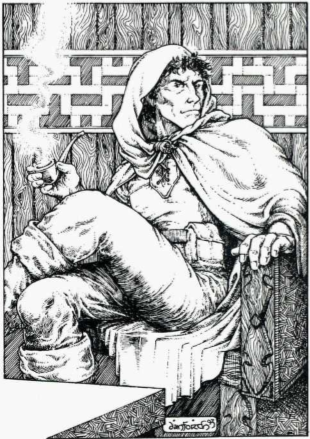
Strider and his customary look of coy amusement.
We now come to a section common to Rolemaster and MERP, "Your Character's Role" which lists a whole bunch of example character traits. Specifically, there are Personality Traits, Motivations, and Alignments. As usual with lists of things from ICE, they're very long and fairly thorough. These aren't rules per se , excepting uses of a small selection of spells that detect and mess with them. They're mostly here as a big list of jumping off points so that you can get a handle on who your character is.
Personality Traits are listed as two opposing things and cover stuff like being an extrovert or introvert, being attentive or distracted, valorous or craven, etc. Motivations are along the lines of " Destroy: evil, Sauronic forces, culture/race, country, guild, population center, individual, etc. " and " Fear of (Phobia): heights, darkness, water, etc. " Near the bottom of the list of Motivations is some really compelling shit like " Heroism " and " Adventure ." Finally, Alignment is a list of spectrums, with "Neutral" unnecessarily listed in the middle of all of them. These start out with Good/Evil, Law/Anarchy and then get more interesting with stuff like Religion/Atheism, Religion/Opposing Religion, Free Enterprise/Socialism and last of all Metaphorical/Literal. Footnotes for certain Alignments point to real world examples like the opposing sides in the War of the Roses, Christians vs. Moslems and the War of Northern Aggression.

Now we get to the important parts of an RPG: Numbers and dice rollin'! Just kidding, it's only numbers for now. We start with the usual opening summary of what we're about to read, then we get BT-1 — Stat Bonuses Table (like D&D Abilities) and BT-2 — Stat Bonuses Effect Table which just lists which skills get bonuses from which stats. After that are descriptions and abbreviations for the stats: Strength (ST), Agility (AG), Constitution (CO), Intelligence (IG), Intuition (IT) and Presence (PR). Shockingly innovative! And another indicator that MERP is meant to be a gateway into Rolemaster, since this is a stripped down selection from the 10 stats in the parent game.
Section 5.2 is "Culture and Race" where we learn just where ICE comes down on Nature vs. Nurture.
 We have a list of the cultures, which will have expanded rules impact on creating a character but we're not going to explain that here with all the other stuff like that because . Despite the relatively expansive approach ICE takes to its world-building, we encounter the typical fantasy bullshit where non-humans have one culture per race, whereas Men are distinguished by over a dozen of their own cultures.
We have a list of the cultures, which will have expanded rules impact on creating a character but we're not going to explain that here with all the other stuff like that because . Despite the relatively expansive approach ICE takes to its world-building, we encounter the typical fantasy bullshit where non-humans have one culture per race, whereas Men are distinguished by over a dozen of their own cultures.
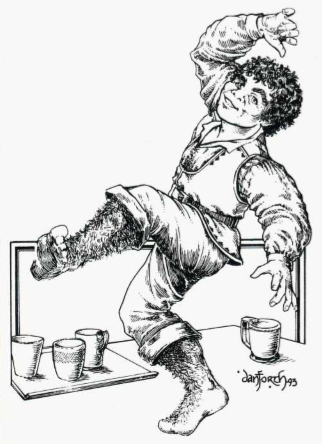
It is Hobbit custom that you sniff toes when they are presented. Sniff!
We get more uselessly vague descriptions of rules that will be fully explained two chapters later when we actually get to make characters. These include racial bonuses for stats, "Background Options", which are a handful of points for a sort of backstory-building subsystem where you buy unique character abilities, unique and magic items, extra skill points, boosted stats, additional known languages and also just money. We are then advised to create a backstory for our character.
Now we come to Physical Appearance, which is broken down into three bits. This includes
After that we come to some short descriptions of each of the professions (classes). They are presented with helpful little parentheticals that mostly just line up to D&D analogues. We have:
• Warrior (Fighter
 )
)
• Scout (Thief
 )
)
• Ranger (Tracker
 )
)
• Bard (Jack-of-all-trades
 )
)
• Mage (Magician
 )
)
• and Animist (Cleric
 )
)
Then we have a section on skills, which includes a barely usable conversion chart for LOR characters, and BT-4 — Skill Rank Bonus Table that I will not get into here because, like most interesting things, that can wait for the actual character building chapter. ICE just really likes reprinting its tables! We once again describe the types of maneuvers: Moving Maneuvers (MM), Static Maneuvers (SM), attack maneuvers using Offensive Bonus (OB). We also have what I erroneously called "Special Maneuvers" in the last post, but they are actually "Special Purpose" skills (SP) because you don't actually use them like other skills.
These abbreviations are pretty much never important.
Skills are broken down into skill categories, which are used to restrict how your character develops based on his
Let's go ahead and get the skill list out of the way:
Movement & Maneuvering Skills
No Armor , Soft Leather , Rigid Leather , Chain and Plate
These are all pretty self-explanatory. You use these skills when you perform Moving Maneuvers. Your skill bonus is subject to a cap based on what armor you're wearing.
Weapon Skills
1-Handed Edged , 1-Handed Concussion , 2-Handed , Pole-arms , Thrown and Missile
Evocative fantasy game naming conventions are go. Again, mostly self-explanatory. The weapons you use are categorized into these six skills. "Pole-arm" means "spear and long-ax", because quarterstaves fall under 2-Handed, while "Missile" means "bows" because you shoot firebolts with a different skill.
General Skills
Climb , Ride , Swim and Track
Climb, Ride and Swim could easily have been subsumed by Movement & Maneuvering, and Track could've gone in Miscellaneous with Perception. This skill category exists to give Rangers another leg up on Warriors, because Aragorn is just dreamy.
Subterfuge Skills
Ambush , Stalk/Hide , Pick Lock and Disarm Traps
Since we don't have thieves even though this is clearly the thief skill category, this one goes to the Scout.
Magical Skills
Read Rune , Use Item and Directed Spells
Cast spells from scrolls; use magic item; and hit-a-dude with magic blasts.
Miscellaneous Skills
Perception , Body Development , Spell Lists and Languages
Body Development = Hit Points. Yes, it's a skill in ICE's games. Even though this edition of MERP was published in 1993, it's still very much a product of the 80's, because each rank of Body Development nets you 1d10 hit points. ICE wouldn't get away from this stupidity until 1995 with Rolemaster Standard Edition . This is also really the only place where spells and languages are talked about as skills, because apart from using up your skill points to learn them they do not behave anything like the other skills.
Secondary Skills
This is the catchall garbage bin where you dump skill points you don't want to spend on useful adventuring +numbers. We get a list (in chart form!) of a bunch of specific examples, like Acrobatics, Caving, Gambling and Sky-Watching. Then there's a set of Secondary Skill Groups which provide a loose framework for you to make your own secondary skills; this describes what stat bonus applies to the group's skills, and what core skill categories you can raid for the skill points you want to dump into your underwater basket-weaving. The Secondary Skill Groups are: Artistic, Athletic, Craft, Influence and Lore.
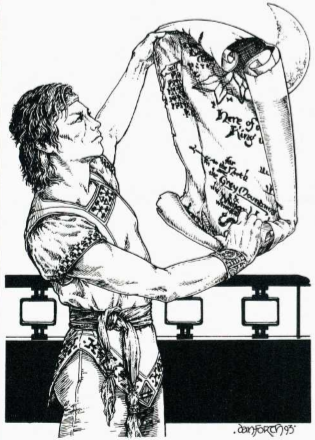
Elrond, that's no way to treat an ancient scroll. You dick.
"5.5 • Experience Level" is a paragraph that boils down to "see two pages from now." The following sections on spells and the learning thereof are equally pointless
 . We then get to "5.7 • Miscellaneous Factors" which describes Resistance Rolls (saving throws), Defense Bonus (DB), Equipment & Money which out of nowhere breaks out some actual rules for shields, helmets, and greaves; and then a paragraph about Encumbrance Penalty with associated chaaaaaaart
BT-5 — Weight Penalty Table
.
. We then get to "5.7 • Miscellaneous Factors" which describes Resistance Rolls (saving throws), Defense Bonus (DB), Equipment & Money which out of nowhere breaks out some actual rules for shields, helmets, and greaves; and then a paragraph about Encumbrance Penalty with associated chaaaaaaart
BT-5 — Weight Penalty Table
.
Oh, hey, look, it's our old friend from 10 pages ago, Stat Bonuses Table!
Once more, all this shit will be explained better in another chapter, with all the same charts and lists. Yes, even the two pages of Personality Traits. I mean, it's fine to have a summary and all, but this stuff goes on and on and on for 20 pages.
Chart Count: 7
List Count: 7
Duplicated Charts or Lists: 1 (oh, just you wait)
Wow, that was a really boring section. I hope the next one is more entertaining. Stick around for Chapter III—Book Part II: Subsection 6.0 • +13xp for 'E' critical hits vs. babies and invalids !
kill points - # hits against enemy x severity of hits + # spells cast + # successful back flips = total xp per encounter
Original SA postPlague of Hats posted:
Chart Count: 7
List Count: 7
Duplicated Charts or Lists: 1 (oh, just you wait)
Wow, that was a really boring section. I hope the next one is more entertaining. Stick around for Chapter III—Book Part II: Subsection 6.0 • +13xp for 'E' critical hits vs. babies and invalids !
MIDDLE-EARTH ROLE PLAYING
SECTION 3
kill points - # hits against enemy x severity of hits + # spells cast + # successful back flips = total xp per encounter
This is gonna be a little short because it's the last section of this part of the book. I could've crammed it in at the end of the previous post, but it was already getting kind of long.
Anyway, allow me to editorialize a little bit.

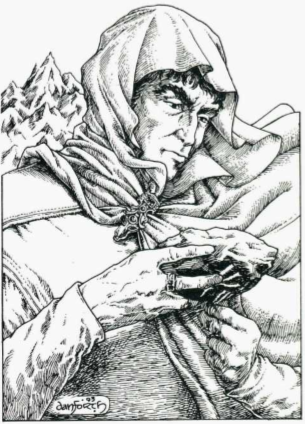
After decades spent with the Elves or alone in the wilderness, Strider falls in love with a rock.
That brings us to the subject of this update: Experience in MERP. This is one of those parts of ICE's games that is written in a completely indefensible way. This is accounting sheet bullshit. In a game system full of optional bells and whistles that rarely tell you they are optional, this is an incredibly important subsystem that just up and tells you "Here is how it is. This is where fun comes to die." I
We of course begin with some boilerplate explanation of experience points, then dive directly into
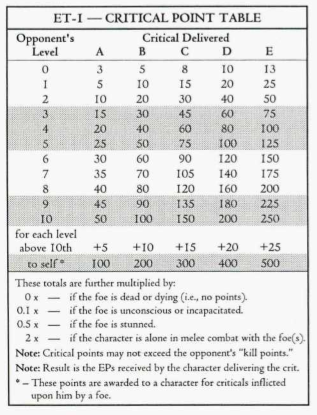
quote:
Note: The suggested experience points awards are guidelines, and the Gamemaster should feel free to modify them whenever common sense indicates that they are out of line.
Note: All of these totals may be multiplied by 4 if the activity has never been performed before by the character, by 2 if the activity has only been performed once before, and by 1/2 if it has become routine.
You have
 At the end of every fight everyone gains a number of experience points equal to the number of hits points of damage that they lost. Per the table above, you also gain experience points for each critical hit inflicted on a foe "regardless of effect." This seems to imply that even if they have a power to make them immune to your critical hit, you gain the experience. The very next sentence then says these points "are modified depending on the state of the foe and the combat." So, uh, whatever.
At the end of every fight everyone gains a number of experience points equal to the number of hits points of damage that they lost. Per the table above, you also gain experience points for each critical hit inflicted on a foe "regardless of effect." This seems to imply that even if they have a power to make them immune to your critical hit, you gain the experience. The very next sentence then says these points "are modified depending on the state of the foe and the combat." So, uh, whatever.
The last
 specific experience point type are Kill Points, with a page-spanning chart. Like most of the larger charts, it's a handy reference for a deceptively simple formula. If you kill something that is the same level as you, you get 200xp. For each level by which your foe's exceeds yours, you get +50xp. The reverse applies if you kill something lower-level…unless you hit a soft floor of 150xp or are killing something that is level 0. Stepping down past 150xp you lose 20xp until you hit 110xp, then you start losing 10xp per level of difference. Except if your opponent is level 0, in which case you're losing as much as 150xp (level 1 killer vs. level 0 victim) or as little as 45xp (level 10 killer).
specific experience point type are Kill Points, with a page-spanning chart. Like most of the larger charts, it's a handy reference for a deceptively simple formula. If you kill something that is the same level as you, you get 200xp. For each level by which your foe's exceeds yours, you get +50xp. The reverse applies if you kill something lower-level…unless you hit a soft floor of 150xp or are killing something that is level 0. Stepping down past 150xp you lose 20xp until you hit 110xp, then you start losing 10xp per level of difference. Except if your opponent is level 0, in which case you're losing as much as 150xp (level 1 killer vs. level 0 victim) or as little as 45xp (level 10 killer).
But wait, there's more math! The number of Kill Points the killer/defeater of an enemy gets is reduced by the number of experience points that have been/will be handed out for each critical hit dealt to that enemy. This means that PCs fighting roughly on-par opponents will be getting potentially bucket loads more experience as they whittle away at them with tons of critical hits, and then the extra reward for delivering the killing blow ends up being jack shit. To offset this the book suggests GMs give out bonus experience for defeating really tough enemies, because otherwise why would you use this fucking stupid subsystem?
Let's not forget that you should be multiplying these numbers by 1/2 if you're a serial murderer, and we're playing a game where the experience difference between levels is measured in the tens of thousands. (Oh, had I not mentioned that?) Have fun erasing 14,870 and rewriting 14,872 on your character sheet!
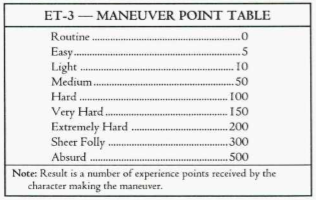
Oh, do you not know what maneuver difficulties are? Well sorry, your princess is in another chapter.
The fourth kind of experience point award is for maneuvers in general. You get experience based on the difficulty for successfully executing a static or moving maneuver. Static maneuvers tend to have pretty clear-cut success/fail delineation, but moving maneuvers do not. Like everything else this will be explained in detail later, but as a quick summary, the moving maneuver chart gives you a sort of percentage rating of how much of your maneuver you've accomplished. You're 80% done crawling up the cliff, you're 150% done jumping to catch a tree branch (i.e., you succeeded so well you caught a higher branch than you were aiming for). So how does that work into the experience awards for maneuvers? It doesn't. You just get a flat amount of experience if you succeed with 100% or more.

You get 0xp for succeeding at a Routine maneuver, which is great since the only reason the GM should be making you roll those is because he's hoping your dice screw you with an automatic failure.
Experience award type number five is Spell Points. You get 100xp per spell cast, -10xp for each character level you have above the spell level. Oh, did you not know that spells come in levels, or whatever? Another chapter, etc.! For some reason the dead simple formula for this type of experience is presented to us here. I think this is the only time they do that in the whole book, and it is also the least necessary time to do so.
Experience type #6 is "Idea Points". This is where the GM just chucks experience points at the players for "ideas, plans and suggestions" of theirs that "prove useful." You do this by totaling all the FIGHT experience points plus maneuver points, halving that, and then distributing whatever number you come up with for their good ideas. That sure sounds like fun! We are treated to an example of awarding Idea Points to the players of the sample adventure from before, where the PCs bumble onto some Orcs in an abandoned tower.
Drogo gets more Idea Points than anyone because he "performed new actions each turn and essentially made a good choice each turn." That sounds a lot better than "scouted, scouted some more, then fumbled an attack on a fleeing Orc." Nári and Agonar get close to the same amount because they both just sort of stood there waiting to kill shit. Leanan of course gets much less than anyone else, because she was a greedy shit. This game is about killing Orcs and then looting their treasure, ya idjit.
The second #6 on our list are Travel Points. You get a base of 1xp per mile traveled by land, or per 10 miles by sea or flight, x0.5 when in civilized regions, x2 or x3 for increasingly dangerous areas. Exciting stuff, I know!
The final two sections explain how much experience each level requires and what happens when you go up a level (the usual bullshit). Level 1 requires 10,000xp and characters start at level 1, so everyone starts with a giant, unnecessary number on their sheet. Each level up to 5 requires 10,000xp more, and each level thereafter requires 20,000xp up to level 10.
The whole book is written with levels 1-10 in mind, with a few exceptions here and there, like the formula to determine skill ranks beyond those available at level 10. Of course, if we get to any of the supplements you'll see how well they stick to this implied range of gameplay. (Spoiler: Most NPCs are at least level 20+, and they enthusiastically stat up long-dead Elven kings as level 150.)
Chart Count: 5 (total: 12)
List Count: 0 (total: 7)
Duplicated Charts or Lists: 0 (total: 1)
Tune in next time when we learn how actions work in How I blew my Running Moving Maneuver roll and ran -40' for 10 seconds .